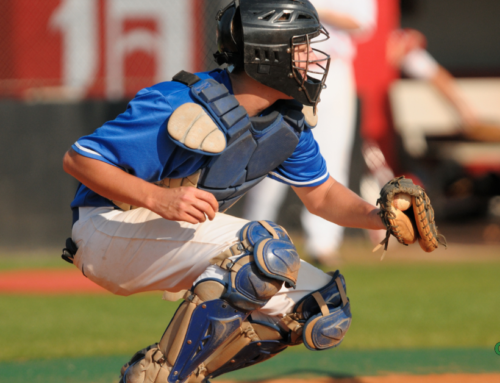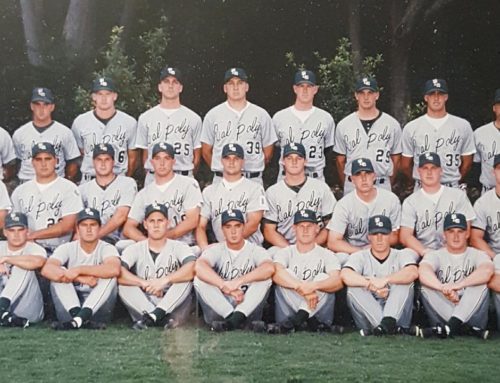
Ready to step up your game as a catcher? Well, you’re in for a treat! We’re going to explore the exciting world of catching in baseball. We’re here to give you all the insider tips and knowledge to help you take your game to a new level.
We’ll cover everything from nailing that perfect stance and getting your footwork right to ensuring you’re on the same wavelength as your pitchers. Whether you’re a coach trying to nurture young talents or a player eager to fine-tune your skills, our expert advice and strategies help you shine on the field.
We’ve got years of experience in the game, so we get what young catchers like you go through. Our guide is tailor-made to help you tackle those common challenges head-on and make the most of your time on the diamond.
Ready to become a force to be reckoned with behind the plate? Well, let’s dive in and master the art of catching like never before!
Master the Art of Catching: Learn How The Pro’s Do It

The role of a baseball catcher
A baseball catcher is more than just the guy who catches pitches. They’re like the team’s quarterback, calling the shots from behind the plate. Catchers are the ones who keep an eye on the field, direct their teammates, and have secret conversations with the pitcher to outsmart the other team.
To rock this all-important role, catchers need to be a special breed. They’ve got to have lightning-quick reflexes, a cannon of an arm (the athleticism to) throw out those speedy baserunners, and the superpower to size up the game and react in a flash. Plus, they’ve gotta be as tough as nails, dealing with the physical demands and the crazy pressure that comes with the job.
Benefits of Developing Young Catchers
Investing time and effort into developing young catchers is like planting seeds of success that can sprout big rewards for the player and the whole team. When coaches nurture their skills and let them spread their wings, they’re basically crafting the MVPs of their defense.
But it’s not just coaches who benefit. Young catchers hit the jackpot with this position. Catching isn’t just about snagging pitches; it’s like getting a backstage pass to the game. It’s a crash course in strategy and pitch plotting. Plus, it’s a masterclass in leadership. Catchers have to be the cheerleaders and drill sergeants all rolled into one, keeping their teammates on point. And here’s the kicker: It’s like their audition for college scouts and pro teams. Catchers are like the diamonds in the rough that every recruiter is looking for because they know how to handle the heat.
Catching fundamentals: Stance, framing, and blocking
To become a top-notch catcher, it’s all about nailing the basics. Think of it like building a solid house – it starts with the foundation. And for catchers, that foundation is having the right stance. They can handle those incoming pitches like a pro when they’re in a comfortable, balanced & athletic ready-to-pounce position.
But wait, there’s more to it than just the stance. Catchers need to be masters with their gloves too. Ever heard of framing? It’s like the catcher’s secret weapon for convincing umpires that a pitch is a strike. They’ve got to finesse the art of making the ball look good. Getting extra strikes can change the outcome of an at-bat, inning and even the game.
And then there’s blocking – the superhero move of stopping wild pitches from turning into free passes for baserunners. Catchers must be fearless and lightning-fast, using proper technique to keep that ball right before them. Human instinct tells us to get out of the way of something flying at you. Catchers need to go against what their brain instinctually tells them to do and jump in front, on purpose, with the understanding that it might hurt a little bit.
Developing throwing skills for catchers
A catcher’s throwing arm can be a difference maker in the outcome of a game. is like their secret superpower. Catchers need to have the ability to get rid of the ball extremely quickly while also having pinpoint accuracy and a cannon for an arm to rock this part of the game. And guess what? It all starts with their feet. Yep, footwork is the name of the game, helping them get rid of the ball quickly and generate that power and oomph for those killer throws.
But here’s the real kicker: speed matters. Catchers need to be lightning-quick with their release. It’s all about how fast they can go from catching the ball to firing it like a bullet. That’s how they stop baserunners in their tracks and keep those stolen bases at bay.
So, time spent training is essential. Catchers must whip out those drills and exercises that turbocharge their throwing skills. And when they do, they’ll be the best behind the plate, making those plays that leave everyone in awe.
Strengthening and conditioning exercises for catchers
Playing catcher isn’t a walk in the park – it’s a workout! Catchers need to be in peak physical shape to handle the game’s grind. That’s where strength and conditioning come into play, and trust me, they’re game-changers.
So, what’s on the menu for a catcher’s fitness routine? Well, it’s a bunch of different exercises that cover all the bases. First up, there’s the core – the powerhouse of your body. Think crunches, rotational med ball throws and planks. squats, lunges, and planks. These build up your lower body and give you that rock-solid stability and power when crouching behind the plate.
But we’re still going! Catchers need the heart of a sprinter and the nimbleness of a ninja, so throw in some cardio & quick feet workouts. It’s all about boosting endurance and agility.
When catchers put in the sweat equity with these exercises, they’re becoming baseball machines, ready to tackle anything the game throws their way.
Mental skills training for catchers
Being a catcher isn’t just about physical prowess; it’s a mind game too. Mental preparation is like the secret sauce that separates the good from the great. Catchers need a rock-solid mental game to steer the ship, stay calm under pressure, and make lightning-fast decisions on the field.
So, what’s the playbook for mental training? Think focus, concentration, and situational awareness. Catchers must be locked in to anticipate what’s coming and be ready for it. Visualization is their superpower – they can mentally rehearse those game scenarios, so they’re always one step ahead.
But it’s not all about being Zen; it’s also about keeping a lid on emotions. Catchers must be calm in the storm, even when the game’s on the line. When they’ve got the mental game down, they’re like the chess masters of baseball, always thinking two moves ahead.
Catching drills and practice techniques
You’ve got it! Practice is the name of the game, and catchers have a whole arsenal of drills and techniques to hone their skills. It’s all about becoming a defensive wizard. One fan favorite is the blocking drill. Imagine catching those dirt-diving pitches and then springing back into action to nab those pesky baserunners. It’s like a superhero training montage!
And let’s not forget the pop-up drill. Catchers need to be like outfielders when it comes to tracking and catching those high-flying pop flies. It’s all about getting in sync with the ball and making it look effortless.
When these drills become a regular part of practice, catchers level up their skills and strut onto the field with a boatload of confidence. They’re the guardians of the plate, ready for whatever curveballs the game throws their way.
Coaching strategies for young catchers
Coaches, they’re like the guiding stars in a catcher’s journey. They hold the keys to unlocking that full potential and turning young talents into stars.
First off, there’s the art of feedback. Coaches need to be like expert sculptors, chiseling away to reveal the masterpiece within each catcher. It’s all about giving them personalized tips and tricks to fix their unique quirks and quirks.
But there’s more to it than just the technical stuff. Coaches need to be buddies, too. Building that trust and open communication is like the secret sauce. Catchers need to know their coach has their back, on and off the field.
Here’s a fun one: practice like it’s game day. Coaches can throw in some high-pressure situations to prep those catchers for the real deal. It’s like throwing them into the fire to forge leaders and decision-makers.
With coaches leading the charge, young catchers are like diamonds in the rough, ready to sparkle on the field and beyond.
Resources for catching development
The quest for catching excellence doesn’t stop on the field. There’s a treasure trove of resources just waiting to help catchers level up their game.
First up, there are books, videos, and online courses. It’s like having a library of baseball wisdom at your fingertips. These resources help give you all the tricks and techniques straight from the pros and seasoned coaches.
But let’s remember catching camps and clinics. It’s like getting a backstage pass to the baseball world. You’re rubbing shoulders with the experts, getting hands-on instruction, and soaking up wisdom from the best in the business.
Our favorite is, of course, our Catching Guy camps with Coach Todd. Dive into the world of catching like never before as our expert instructors guide you through essential skills, drills, and strategies to take your game behind the plate to the next level. Whether you’re a young aspiring catcher looking to build a strong foundation or a seasoned player seeking to refine your skills, this camp is tailored to elevate your catching game.
The name of the game is staying ahead of the curve. Baseball’s always evolving, and the best catchers and coaches are the ones who never stop learning and improving. It’s like having an ace up your sleeve when you’ve got the latest tips and trends in your toolkit.
Mastering the art of catching is like embarking on an epic journey. It’s about pouring your heart into it, practicing until your mitt feels like an extension of your hand, and never settling for anything less than your best.
For young catchers, this is the path to becoming indispensable team players. But coaches, we’re the GPS on this journey. It’s our job to light the way, provide that steady hand, and nurture the catcher’s growth.
So, whether you’re a coach or player, deeply dive into the strategies in this guide. Embrace the tough stuff, challenge yourself, and get ready to become a force to be reckoned with behind the plate. The art of catching is waiting, and the potential is limitless. Let’s play ball!






